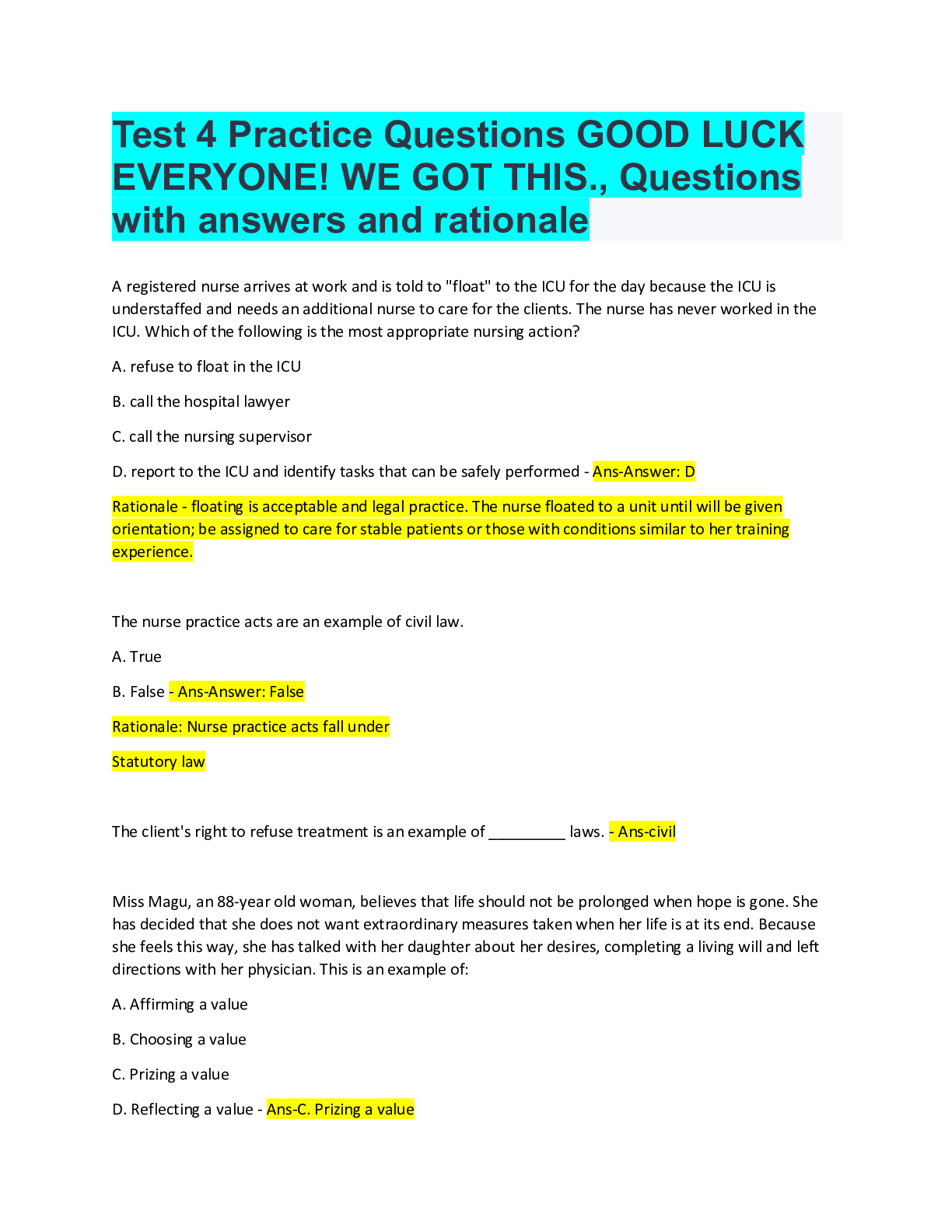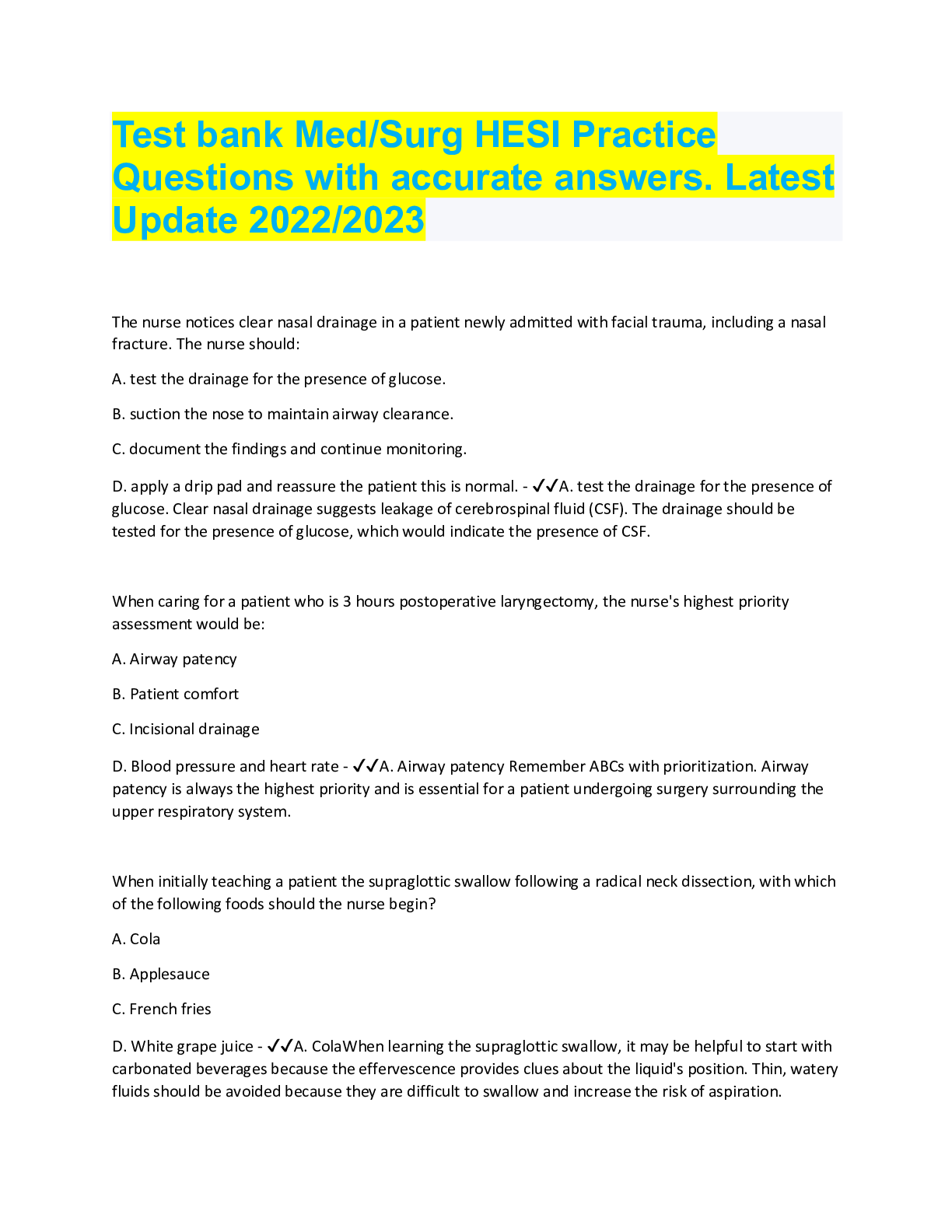*NURSING > TEST BANK > LEIK FNP Practice Questions with 100% accurate answers, TEST BANK, 2022/2023. COMPREHENSIVE (All)
LEIK FNP Practice Questions with 100% accurate answers, TEST BANK, 2022/2023. COMPREHENSIVE
Document Content and Description Below
LEIK FNP Practice Questions with 100% accurate answers, TEST BANK, 2022/2023. COMPREHENSIVE A 72-year-old woman has been on hydrochlorothiazide 12.5 mg for many years to control her Stage II hype... rtension. Her blood pressure (BP) at this visit is 168/96. She is currently complaining of pain on her right hip and on both knees. She has increased her dose of ibuprofen (Motrin) from 400 mg 3 times day (TID) to 800 mg TID. She is still in pain and would like something stronger. Which of the following statements is the best explanation of the effects of ibuprofen (Motrin) on her disease? A) It increases the chances of adverse effects to her health B) It inhibits the effect of renal prostaglandins and blunts the effectiveness of the diuretic C) It prolongs the therapeutic effects of hydrochlorothiazide and other diuretics D) None of the statements are true - ✔✔B) It inhibits the effect of renal prostaglandins and blunts the effectiveness of the diuretic. NSAIDs and ASA inhibit the vasodilatory effects of prostaglandins, which predisposes the kidney to ischemia. NSAIDs and diuretics can cause acute prerenal failure by decreasing renal blood flow. 2. All of the following are infections that affect mostly the labia and vagina except: A) Bacterialvaginosis B) Candidiasis C) Trichomoniasis D) Chlamydia trachomatis - ✔✔D) Chlamydia trachomatis Infections that commonly affect the labia and vagina include bacterial vaginosis, candidiasis, and trichomoniasis. Chlamydia trachomatis commonly affects the cervix, endometrial lining , fallopian tubes, and pelvic cavity. The nurse practitioner would test the obturator and iliopsoas muscle to evaluate for: A) Cholecystitis B) Acute appendicitis C) Inguinal hernia D) Gastriculcer - ✔✔B) Acute appendicitis. Signs and symptoms of an acute abdomen include invol- untary guarding, rebound tenderness, boardlike abdomen, and a positive obtu- rator and psoas sign. A positive obturator sign occurs when pain is elicted by internal rotation of the right hip from 90 degrees hip/knee flexion. The psoas sign is positive when pain occurs with passive extension of the thigh while the patient is lying on his/her side with knees extended, or when pain occurs with active flexion of his/her thigh at the hip. Treatment for mild preeclampsia includes all of the following except: A) Bed rest except for bathroom privileges B) Close monitoring of weight and blood pressure C) Close follow-up of urinary protein, serum creatinine, and platelet count D) A prescription of methyldopa (Aldomet) to control blood pressure - ✔✔D) A prescription of methyldopa (Aldomet) to control blood pressure Recommended care for women diagnosed with preeclampsia includes bed rest with bath- room privileges, weight and BP monitoring, and closely following urine protein and serum protein, creatinine, and platelet counts. Oral medications are not used as first-line treatment. All of the following services are covered under Medicare Part A except: A) Inpatienthospitalizations B) Medicines administered to a patient while hospitalized C) Nursing home care D) Surgeons - ✔✔C) Nursing home care Medicare A coverage includes inpatient hospitalization and skilled care given in a certified skilled nursing facility. Most nursing home care is custodial care (help with bathing, dressing, using a bathroom, and eating). This care is not covered by Medicare A. A 28-year-old student is seen in the school health clinic with complaints of a hacking cough that is productive of small amounts of sputum and a runny nose. He does not take any medications, denies any allergies, and has no significant medical history. Physical examination reveals a low-grade temperature of 99.9 degrees Fahrenheit, respirations of 16/min, a pulse of 90 beats per minute, and diffuse fine crackles in the base of the lungs. A chest radiograph (x-ray) shows diffuse infiltrates on the lower lobe of the right lung. The total white blood cell count is 10,500/uL. What is the most likely diagnosis? A) Streptococcal pneumonia B) Mycoplasma pneumonia C) Acute bronchitis D) Legionnaires disease - ✔✔B) Mycoplasma pneumonia Mycoplasma pneumonia is the organism most com- monly seen in children and young adults. It is easily spread from droplets, from sneezing and coughing, in close proximity. Diagnosis is based on symptoms and x-ray results of infiltrates in lower lobes. A 39-year-old migrant worker presents to the clinic 2.5 days after a purified protein derivative (PPD) test. What minimum size of induration would be considered posi- tive for this patient? A) 3 mm B) 5 mm C) 10 mm D) 15 mm - ✔✔C) 10 mm The PPD is administered on the volar aspect of the lower arm and read 48 hours after the test is given. The PPD result must have induration and measure 10 mm or greater to be positive in a low-risk patient. Induration (firmness with palpation) must be present. If the site has erythema but no induration, result would be negative. Color is not important. All of the following are correct statements regarding the role of the person named in a durable power of attorney except: A) The agent's decisions are legally binding B) The agent can make decisions in other areas of the patient's life such as financial issues C) The agent can decide for the patient who is on life support when that life support can be terminated D) The patient's spouse has a right to override the agent's decisions - ✔✔D) The patient's spouse has a right to override the agent's decisions The person named in a durable power of attorney (the agent) is designated by the patient to make all medical decisions, as well as any decisions regarding the patient's private affairs in the event that the patient becomes incompetent and unable to make his/her own decisions. No one has the ability to override the agent's decision. All of the following are true statements regarding Munchausen syndrome except: A) It is considered a mental illness B) The patient has a medical illness that causes an anxiety reaction and denial C) The patient fakes an illness in order to gain attention from health care providers D) The patient has an inconsistent medical history along with a past history of frequent hospitalizations - ✔✔B) The patient has a medical illness that causes an anxiety reaction and denial Munchausen syndrome is a psychiatric disorder in which the patient fakes a medical illness or disorder to gain attention from health care provid- ers. These patients commonly use the emergency department frequently to gain attention. Which of the following antihypertensive medications should the nurse practitioner avoid when treating patients with emphysema? A) Calcium channel blockers B) Angiotensin-converting enzyme (ACE) inhibitors C) Beta-blockers D) Diuretics - ✔✔C) Beta-blockers Beta-blockers should be avoided in patients with a history of emphysema. Studies have shown evidence of a reduction in forced expiratory volume in 1 second (FEV1), increased airway hyperresponsiveness, and inhibition of bronchodilator response to beta agonists in patients receiving non-selective beta- blockers and high doses of cardioselective beta-blockers. A 30-year-old chef complains of pruritic hives over her chest and arms but denies difficulty swallowing or breathing. She reports a family history of allergic rhinitis and asthma. Which of the following interventions is most appropriate? A) Perform a complete and thorough history B) Prescribe an oral antihistamine such as diphenhydramine 25 mg PO QID C) Give an injection of epinephrine 1:1000 intramuscularly stat D) Call 911 - ✔✔A) Perform a complete and thorough history Prior to prescribing medications, a complete and thorough history must be performed to determine possible causes of hives. The patient denied difficulty with swallowing and breathing, so there was no medical emergency to require calling 911. Which of the following findings is most likely in young primigravidas with pregnancy-induced hypertension? A) Abdominal cramping and constipation B) Edema of the face and the upper extremities C) Shortness of breath D) Dysuria and frequency - ✔✔B) Edema of the face and the upper extremities Common signs and symptoms of pregnancy-induced hypertension include edema of the face and the upper extremities, weight gain, blurred vision, elevated BP, proteinuria, and headaches. Which of the following symptoms is associated with B12 deficiency anemia? A) Spoon-shaped nails and pica B) An abnormal neurological exam C) A vegan diet D) Tingling and numbness of both feet - ✔✔D) Tingling and numbness of both feet Vitamin B12 deficiency anemia can cause nerve cell damage if not treated. Symptoms of B12 deficiency anemia may include tingling or numbness in fingers and toes, difficulty walking, mood changes or depression, memory loss, disorientation, and dementia. A second triple screen on a 35-year-old primigravida reveals abnormally low lev- els of the alpha fetoprotein and estriol and high levels of human chorionic gonad- otropin. Which of the following interventions is the best choice for this patient? A) Order an ultrasound B) Order a computed tomography (CT) scan of the abdomen C) Order a 24-hour urine for protein clearance D) Assess for a history of illicit drug or alcohol use - ✔✔A) Order an ultrasound Abnormally low levels of alpha fetoprotein and estriol and high levels of human chorionic gonadotropin are abnormal during pregnancy. An ultrasound should be ordered to further evaluate the fetus for characteristics of Down syndrome and/or fetal demise. All of the following are true statements about diverticula except: A) Diverticula are located in the colon B) A low-fiber diet is associated with the condition C) Most diverticula in the colon are infected with gram-negative bacteria D) Supplementingwithfibersuchaspsyllium(Metamucil)isrecommended - ✔✔C) Most diverticula in the colon are infected with gram-negative bacte- ria Diverticuli in the colon can be infected with both gram-negative and gram- positive bacteria. Patients who are diagnosed with gonorrhea should also be treated for which of the following infections? A) Chancroid B) Chlamydia trachomatis C) Herpes genitalis D) PID (pelvic inflammatory disease) - ✔✔B) Chlamydia trachomatis When diagnosed with gonorrhea, the patient should also be treated for Chlamydia trachomatis. Kyphosis is a late sign of: A) Old age B) Osteopenia C) Osteoporosis D) Osteoarthritis - ✔✔C) Osteoporosis Kyphosis is a curvature of the spine that causes a rounding of the back, which leads to a slouching posture. Severe thinning of the bones (osteoporosis) contributes to this curvature in the spine. Symptoms that may occur with severe cases of kyphosis include difficulty breathing, fatigue, and back pain. A 35-year-old primigravida who is at 28 weeks of gestation is expecting twins. What would you would expect her alpha fetoprotein (AFP) values to be? A) Normal B) Higher than normal C) Lower than normal D) None of the above - ✔✔B) Higher than normal Alpha fetoprotein is produced in the fetal and maternal liver. Higher levels of alpha fetoprotein are commonly seen in multiple gestations due to the growing fetuses and enlargement of the livers. Which of the following antihypertensive medications has beneficial effects for an elderly White female with osteoporosis? A) Calcium channel blocker B) Angiotensin-converting enzyme (ACE) inhibitor C) Beta-blocker D) Diuretic - ✔✔A) Calcium channel blocker Calcium channel blockers act by blocking the cal- cium channels in the heart muscle and the blood vessels, thereby keeping more calcium in the bones. The Lachman maneuver is used to detect which of the following? A) Knee instability B) Nerve damage of the knee due to past knee injuries C) The integrity of the patellar tendon D) Tears on the meniscus of the knee - ✔✔A) Knee instability The Lachman maneuver is a test performed to assess for knee instability. Knee instability indicates a tear of the anterior cruciate ligament. When an adolescent male's penis grows more in length than width, at which of the following Tanner stages is he classified? A) Tanner Stage II B) Tanner Stage III C) Tanner Stage IV D) Tanner Stage V - ✔✔B) Tanner Stage III Tanner Stage III in males consists of penis lengthening and darker, coarse pubic hair, which begins to curl Fetal TORCH infections can cause microcephaly, mental retardation, hepatospleno- megaly, and intrauterine growth retardation. The acronym TORCH stands for: A) Toxoplasma gondii, other infections, rubella, cytomegalovirus, and herpes B) Toxic shock syndrome, ocular infections, rubella, cytomegalovirus, and herpes zoster C) Tetanus, ophthalmic infections, roseola, cancer, and head abnormalities D) Toxins, other infections, roseola, candidiasis, and head abnormalities - ✔✔A) Toxoplasmagondii, other infections, rubella, cytomegalovirus, and herpes The acronym TORCH stands for Toxoplasma gondii, other infections, rubella, cytomegalovirus, and herpes. Although several of the conditions listed in the other answer options can also cause fetal problems, they are not included in the TORCH acronym. Human papilloma virus (HPV) infection of the larynx has been associated with: A) Laryngeal neoplasia B) Esophageal stricture C) Cervical cancer D) Metaplasia of esophageal squamous cells - ✔✔A) Laryngeal neoplasia HPV infection of the larynx has been associated with laryngeal neoplasia; HPV infection of the cervix is associated with cervical cancer. Mr. Brown is a 65-year-old carpenter complaining of morning stiffness and pain in both his hands and right knee upon awakening. He feels some relief after warming up. On exam, the nurse notices the presence of Heberden's nodes. Which of the fol- lowing is most likely? A) Osteoporosis B) Rheumatoid arthritis C) Degenerative joint disease D) Reiter's syndrome - ✔✔C) Degenerative joint disease Heberden's nodes are commonly seen in degenerative joint disease. Heberden's nodes are bony nodules located on the distal interphalangeal joints (DIPs). What does a positive posterior drawer sign in a 10-year-old soccer player signify? A) An abnormal knee B) Instability of the knee C) A large amount of swelling on the knee D) An injury of the meniscus - ✔✔B) Instability of the knee The drawer sign is performed on the knee or ankle to assess for knee instability. The affected knee will have more laxity when compared to the unaffected knee. A multigravida who is at 28 weeks of gestation has a fundal height of 29 cm. Which of the following is the best recommendation for this patient? A) Advise the mother that her pregnancy is progressing well B) Order an ultrasound of the uterus C) Refer her to an obstetrician for an amniocentesis D) Recommend bed rest with bathroom privileges - ✔✔A) Advise the mother that her pregnancy is progressing well From 20-35 weeks' gestation, fundal height should equal weeks gestation. If greater than 2 cm within the gestational week of pregnancy, further testing should be performed to evaluate fetal growth A multigravida who is at 34 weeks of gestation wants to know at what level her uterine fundus should be. The best answer is to advise the mother that her fun- dus is: A) Midway between the umbilicus and the lower ribs B) At the level of the umbilicus C) From 33 to 35 cm D) From 32 to 34 cm - ✔✔C) From 33 to 35 cm After 20 weeks gestation, fundal height in centimeters should measure approximately the same as the number of weeks of gestation Which of the following laboratory tests is used in primary care to evaluate renal function? A) Electrolyte panel B) Creatinine C) Alkaline phosphatase D) Blood urea nitrogen (BUN) to creatinine ratio - ✔✔B) Creatinine Serum creatinine is measured to evaluate renal function. Creatinine is the end product of creatine metabolism. Creatinine clearance is not affected by fluid or dietary intake of meat. All of the following are false statements regarding acute gastritis except: A) Chronic intake of nonsteroidal anti-inflammatory drugs (NSAIDs) can cause the disorder B) Chronic lack of dietary fiber is the main cause of the disorder C) The screening test for the disorder is the barium swallow test D) The gold standard to evaluate the disorder is a colonoscopy - ✔✔C) The screening test for the disorder is the barium swallow test The gold standard for diagnosing gastric disease is biopsy of gastric and/or duodenal tissue by upper endoscopy. Chronic use of NSAIDs disrupts the production of prostaglandins, which decreases blood supply and then breaks down the protective layer of the mucosa, which leads to gastric disease. Signs and symptoms of depression include all of the following except: A) Anhedonia and changes in appetite B) Decreased energy and irritability C) Apathy and low self-esteem D) Apraxia and fatigue - ✔✔D) Apraxia and fatigue Apraxia is a disorder of the nervous system in which the brain is affected and the patient is unable to move the arms/legs when asked to do so. Common signs of depression include anhedonia (loss of interest in activities that the patient finds pleasurable), unintentional weight loss or gain, fatigue, change in appetite, insomnia or hypersomnia, feelings of guilt and worthlessness, and recurrent thoughts of suicide. Which of the following is an accurate description of eliciting for Murphy's sign? A) Upon deep inspiration by the patient, palpate firmly in the right upper quad- rant of the abdomen below the costovertebral angle B) Bend the patient's hips and knees at 90 degrees, then passively rotate hip exter- nally, then internally C) Ask the patient to squat, then place the stethoscope on the apical area D) Press into the abdomen deeply, then release it suddenly - ✔✔A) Upon deep inspiration by the patient, palpate firmly in the right upper quad- rant of the abdomen below the costovertebral angle Murphy's sign is positive if pain occurs when performing RUQ palpation while the patient takes a deep inspiration, causing the patient to abruptly stop the deep breath due to pain. As the liver is palpated, it will descend and push up against the inflamed gallbladder and cause sharp pain (cholecystitis). A 28-year-old multipara who is at 32 weeks of gestation presents to your office complaining of a sudden onset of small amounts of bright red vaginal bleeding. She has had several episodes and appears anxious. On exam, her uterus is soft to palpation. Which of the following is most likely? A) Placenta abruptio B) Placenta previa C) Acute cervicitis D) Molar pregnancy (hydatidiform mole) - ✔✔B) Placenta previa Placenta previa occurs when abnormal implantation of the placenta occurs. A common symptom of placenta previa is painless, bright red bleeding. Epidemiologic studies show that Hashimoto's disease occurs most commonly in: A) Middle-aged to older women B) Smokers C) Obese individuals D) Older men - ✔✔A) Middle-aged to older women Hashimoto's disease commonly occurs in middle-aged to older women. A 48-year-old woman is told by a physician that she is starting menopause. All of the following are possible findings except: A) Hot flashes B) Irregular menstrual periods C) Severe vaginal atrophic changes D) Cyclic mood swings - ✔✔C) Severe vaginal atrophic changes As women reach menopause, changes that may occur include hot flashes, irregular menstrual periods, and cyclic mood swings. Vaginal changes, such as dryness and thinning, may also begin to occur A 63-year-old patient with a 10-year history of poorly controlled hypertension presents with a cluster of physical exam findings. Which of the following indicate target organ damage commonly seen in hypertensive patients? A) Pedal edema, hepatomegaly, and enlarged kidneys B) Hepatomegaly, AV nicking, bibasilar crackles C) Renal infection, S3, neuromuscular abnormalities D) Glaucoma, jugular vein atrophy, heart failure - ✔✔B) Hepatomegaly, AV nicking, bibasilar crackles With long-term, uncontrolled hypertension, organ damage may occur. Organs commonly affected include: brain (stroke), eyes (retinopathy, AV nicking, bleeding, blindness), heart (heart dis- ease, left ventricular hypertrophy, MI, and/or CHF), and kidneys (renal failure, proteinuria). A 30-year-old primigravida is diagnosed with a possible threatened abortion. The result of the urine pregnancy test is positive. Which of the following statements is true regarding a threatened abortion? A) Vaginal bleeding and cramping are present, but the cervix remains closed B) Vaginal bleeding and cramping are present along with a dilated cervix C) The fetus and placenta are all expelled D) The products of conception and the placenta remain inside the uterus along with a dilated cervix - ✔✔A) Vaginal bleeding and cramping are present, but the cervix remains closed Threatened abortion is defined as vaginal bleeding and cramping with- out the presence of cervical dilation. A 30-year-old female who is sexually active complains of a large amount of milk- like vaginal discharge for several weeks. A microscopy slide reveals a large amount of squamous epithelial cells that have blurred margins. Very few white blood cells are seen. The vaginal pH is at 6.0. What is most likely? A) Trichomonas infection B) Bacterial vaginosis C) Candidal infection D) A normal finding - ✔✔B) Bacterial vaginosis Bacterial vaginosis is a bacterial infection of the vagina. Signs and symptoms include copious off-white to gray discharge with foul odor without vaginal erythema or irritation. Wet prep will show positive for clue cells. When performing a wet prep, the "whiff test" will be positive for a strong "fishy" odor when vaginal discharge is mixed with one drop of KOH. The Pap smear result on a 20-year-old sexually active student who uses condoms inconsistently shows a large amount of inflammation. Which of the following is the best follow-up action? A) The NP needs to do cervical cultures to verify the presence of gonorrhea B) Prescribe metronidazole vaginal cream for the patient over the phone C) Call the patient and tell her she needs a repeat Pap smear in 6 months D) Advise the patient to use a Betadine douche at bedtime x 3 days - ✔✔A) The NP needs to do cervical cultures to verify the presence of gonor- rhea Cultures should be taken at the time of the Pap smear, as the patient may not return for later diagnostic testing. While performing a Pap smear on a postmenopausal patient, several areas of flat white skin lesions that are irregularly shaped are found on the patient's labia. The patient reports that the lesions are extremely itchy and have been present for several years without much change. Which condition is best described? A) Chronic scabies infection B) Lichen sclerosus C) Chronic candidal vaginitis D) A physiologic variant found in some older women - ✔✔B) Lichen sclerosus Lichen sclerosus is a disease of the skin, in which white spots appear on the skin and change over time. It is most commonly seen in the genital and rectal areas, but can appear in other areas. The spots are usually shiny and smooth and can eventually spread into patches. The skin appears thin and crinkled. Then the skin tears easily, and bright red or purple bruises are common. Sometimes, the skin becomes scarred. If the disease is a mild case, there may be no symptoms The heart sound S2 is caused by: A) Closure of the atrioventricular valves B) Closure of the semilunar valves C) Opening of the atrioventricular valves D) Opening of the semilunar valves - ✔✔B) Closure of the semilunar valves The heart sound S2 is caused by closure of the semilunar valves. A pelvic exam on a woman who is 12 weeks pregnant would reveal that her uterus is located at which of the following areas? A) Between the umbilicus and the suprapubic bone B) Just rising above the suprapubic bone C) Between the suprapubic bone and the xiphoid process D) Between the umbilicus and the xiphoid proces - ✔✔B) Just rising above the suprapubic bone At 12 weeks gestation, the uterus measures approximately the size of a grapefruit, which would be felt just above the suprapubic bone on bimanual exam. All of the following are covered under Medicare Part B except: A) Persons age 65 years or older B) Durable medical equipment C) Mammograms annually starting at age 50 D) Anesthesiologist's services - ✔✔D) Anesthesiologist's services Medicare Part B covers: 1) outpatient physician visits, labs, x-rays; 2) durable medical equipment; 3) mammograms/colonoscopy after age 50 years annually; 4) rehabilitation. Anesthesiologist's services are covered by Medicare Part A. All of the following patients are at higher risk for suicide except: A) A 66-year-old White male whose wife of 40 years recently died B) A high school student with a history of bipolar disorder C) A depressed 45-year-old female with family history of suicide D) A 17-year-old teen who has only 1 close friend in school - ✔✔D) A 17-year-old teen who has only one close friend in school Risk factors for suicide include: 1) elderly white males (especially after the death of a spouse); 2) past history of suicide; 3) family history of suicide; 4) plans for use of a lethal weapon such as a gun or knife; 5) female gender has a higher attempt rate, but males have a higher success rate; 6) personal history of bipolar disorder or depression. A 70-year-old male patient complains of a bright red spot in his left eye for 2 days. He denies eye pain, visual changes, or headaches. He has a new onset of cough from a recent viral upper respiratory infection. The only medicine he is on is Bayer aspirin 1 tablet a day. Which of the following is most likely? A) Corneal abrasion B) Acute bacterial conjunctivitis C) Acute uveitis D) Subconjunctival hemorrhage - ✔✔D) Subconjunctival hemorrhage Subconjunctival hemorrhage is a benign disorder that occurs from an increase in intraocular pressure that may be caused by coughing, vomiting, forceful exerrtion in labor during childbirth, straining while having a bowel movement, weight lifting, or lifting a heavy object. Which of the following is appropriate follow-up for this 70-year-old patient? A) Referral to an optometrist B) Referral to an ophthalmologist C) Advise the patient that it is a benign condition and will resolve spontaneously D) Prescribe an ophthalmic antibiotic solution - ✔✔C) Advise the patient that it is a benign condition and will resolve spontaneously A subconjunctival hemorrhage is a benign disorder that resolves without any treatment Jason, an 8-year-old with type 1 diabetes, is being seen for a 3-day history of fre- quency and nocturia. He denies flank pain and is afebrile. The urinalysis result is negative for blood and nitrites but is positive for a large amount of leukocytes and ketones. He has a trace amount of protein. Which of the following is the best test to order initially? A) Urine for culture and sensitivity B) 24-hour urine for protein and creatinine clearance C) 24-hour urine for microalbumin D) An intravenous pyelogram - ✔✔A) Urine for culture and sensitivity An 8-year-old male patient with the diagnosis of diabetes has a high risk of urinary tract infections. A large amount of leukocytes in the urinalysis is abnormal and he has been having symptoms of frequency and nocturia for the past 3 days. The urine culture would be ordered because he has a high risk of infection. The urine culture and sensitivity (C&S) is the best evaluation for diagnosing a urinary tract infection. All of the following are not recommended for the outpatient treatment of mild preeclampsia except: A) Severe sodium restriction B) Restrict fluid intake to less than 1 liter per 24 hours C) Aldomet (methyldopa) 250 mg PO (orally) BID D) Bed rest on the left side with bathroom privileges - ✔✔D) Bed rest on the left side with bathroom privileges Outpatient treatment for mild pre-eclampsia includes bed rest on the left lateral side with bathroom privileges. The best test for diagnosing congenital glaucoma is which of the following? A) Fluorescein staining B) Tonometry C) Snellen vision exam D) The refractive index - ✔✔B) Tonometry A tonometer is used to measure the intraocular pressure (IOP) of the eye to screen for glaucoma. Normal range IOP is 10-22 mm Hg. Rocky Mountain spotted fever is caused by the bite of the: A) Mosquito B) Tick C) Insect D) Flea - ✔✔B) Tick Rocky Mountain spotted fever is caused by a tick bite from a tick that was infected with the parasite Rickettsia rickettsii. The mortality rate is 1%-7% if left untreated. All of the following are false statements about atopic dermatitis except: A) Contact with cold objects may exacerbate the condition B) It does not have a linear distribution C) It is associated with bullae D) The lesions have vesicles that are full of serous exudate - ✔✔B) It does not have a linear distribution Atopic dermatitis is a skin condition in which the lesions occur in a linear fashion. They may have many different stages, including erythematous papules and vesicles, with weeping, drainage, and/or crusting. Lesions are commonly found on the scalp, face, forearms, wrists, elbows, and backs of the knees. Commonly pruritic. Also known as eczema. A mother brings in her 4-year-old daughter who just started attending preschool. She tells the nurse practitioner that her child is complaining of burning and itching in both eyes along with a runny nose. During the physical exam, the child's eyes appear injected bilaterally. The throat is red and her inferior nasal turbinates are swollen. Which of the following is most likely? A) Herpes keratitis B) Corneal ulcer C) Viral conjunctivitis D) Bacterial conjunctivitis - ✔✔C) Viral conjunctivitis Viral conjunctivitis is inflammation of the conjunctiva with common complaints of red, itchy eyes, without signs of infection. A sexually active woman is complaining of amenorrhea and vaginal spotting. On exam, her left adnexa is tender and cervical motion tenderness is positive. Which test should the nurse practitioner initially order? A) Flat plate of the abdomen B) Complete blood count (CBC) with white cell differentials C) Urine pregnancy test D) Pelvic ultrasound - ✔✔C) Urine pregnancy test A urine pregnancy test should be performed to rule out miscarriage and/or tubal pregnancy. A toddler with congenital heart disease is seen for a 1-week history of facial and lower-extremity edema accompanied by shortness of breath. The child's mother reports that the child's appetite has been poor. The chest x-ray reveals that the child has congestive heart failure (CHF). Which of the following heart sounds are found in these patients? A) S1 and S2 B) S1, S2, and S3 C) S1, S2, and S4 D) Still's murmur and S4 - ✔✔B) S1, S2, and S3 Congestive heart failure is the inability of the heart to pump a sufficient amount of blood to the organs to meet the body's requirements. It is common to hear S1, S2, and S3 heart sounds on exam. Common signs and symptoms include fatigue, shortness of breath with activity, and edema of lower extremities. A 53-year-old crossing guard complains of twisting his right knee while working that morning. The knee is swollen and tender to palpation. The nurse practitioner diagnoses a Grade II sprain. The initial treatment plan includes which of the following? A) Application of cold packs the first 24 hours followed by applications of low heat at bedtime B) Elevation of the affected limb and intermittent applications of cold packs for the next 48 hours C) Rechecking the knee in 24 hours and isometric exercises D) The application of an Ace bandage to the affected kne - ✔✔B) Elevation of the affected limb and intermittent applications of cold packs for the next 48 hours Elevation of the injured knee above the heart will reduce the amout of swelling that can occur. Use of ice packs immediately after the injury is most effective and will reduce swelling in the tissue. Ice the affected area for 15 minutes at a time intermittently to prevent frostbite and further damage to tissue. Allowing 30-45 minutes between icings of the limb is recommended. Erythromycin 200 mg with sulfisoxazole 600 mg suspension (Pediazole) is contraindicated in which of the following conditions? A) G6PD deficiency anemia B) Lead poisoning C) Beta thalassemia minor D) B12 deficiency anemia - ✔✔A) G6PD deficiency anemia Glucose-6-phosphate dehydrogenase (G6PD) defi- ciency is a hereditary condition that occurs when the red blood cells break down, causing hemolysis, due to a missing or lack of a sufficient enzyme that is needed to help the red blood cells work efficiently. Certain foods and medications may trigger this reaction and hemolysis will occur. Some of these medications include antimalarial drugs, aspirin, nitrofurantoin, NSAIDs, quinidine, quinine, and sulfa medications. The mother of an 11-year-old boy with sickle cell anemia calls on the phone complaining that her son woke up because of a painful penile erection that will not go away. The nurse practitioner's most appropriate intervention is: A) Insert a Foley catheter and measure the child's intake and output for the next 24 hours B) Insert a Foley catheter to obtain a specimen for a urinalysis and urine for C&S (culture and sensitivity) C) Recommend an increase in the child's fluid intake D) Recommend immediate referral to the ER - ✔✔D) Recommend immediate referral to the ED Priapism (painful penile erection not related to sexual activity) is a true urologic emergency that may lead to permanent erectile dysfunction and penile necrosis if not treated appropriately. It can be associated with a number of medical conditions (sickle cell anemia, leukemia, or spinal cord injury) and/or some pharmacologic agents A positive Coombs test on an Rh-negative pregnant woman means: A) The mother has autoantibodies against Rh-positive red blood cells (RBCs) B) The fetus has autoantibodies against maternal RBCs C) The mother does not have Rh factor against fetal RBCs D) The fetus does not have RBC autoantibodies - ✔✔A) The mother has autoantibodies against Rh-positive red blood cells (RBCs) The mother's autoantibodies can attack the fetus's Rh-positive red blood cells and cause destruction of these cells, which can cause severe anemia and com- plications in the fetus. Today this is preventable with the administration of anti- RhD immunoglobulin (Rho(D) immune globulin) to an Rh-negative mother at 28 weeks gestation and after birth if the newborn is Rh positive. Folic acid supplementation is recommended for women who are planning pregnancy in order to: A) Prevent renal agenesis B) Prevent anencephaly C) Prevent kidney defects D) Prevent heart defects - ✔✔B) Prevent anencephaly Folic acid supplementation during pregnancy has been shown to decrease the risk of neural tube defects of the fetus All of the following are possible causes for secondary hypertension except: A) Acute pyelonephritis B) Pheochromocytoma C) Renovascular stenosis D) Coarctation of the aorta - ✔✔A) Acute pyelonephritis Pheochromocytoma is an adrenal gland tumor in which there is increased production of the hormones adrenaline and noradrena- line, which may cause long-term elevation in blood pressure. Renovascular steno- sis is a narrowing of one or both arteries leading to the kidneys. It can cause severe hypertension and irreversible kidney damage. Coarctation of the aorta is a con- genital heart defect of the aorta; it is a narrowing of the aorta that causes the heart to work harder to get blood to flow through the narrow aortic passageway to other organs, which in turn causes an increase in blood pressure. Fitz-Hugh-Curtis syndrome is associated with which following infection? A) Syphilis B) Chlamydia trachomatis C) Herpes genitalis D) Lymphogranuloma venereum - ✔✔B) Chlamydia trachomatis Fitz-Hugh-Curtis is a complication of having pelvic inflammatory disease that was caused by a vaginal infection, such as gonorrhea or Chlamydia trachomatis. This causes inflammation and infection in the pelvic cavity. Left untreated, this infection can cause adhesions that stretch from the peritoneum to the liver. A nursing home resident reports to his physician that his previous roommate was recently started on tuberculosis treatment. A Mantoux test and chest x-ray are ordered for the patient. What is the minimum size of induration considered positive for this patient? A) 3 mm B) 5 mm C) 10 mm D) 15 mm - ✔✔B) 5 mm To perform the Mantoux test, a dose of 5 tuberculin units in 0.1 mL solution is injected intradermally into the forearm and read 48 to 72 hours later. Results are measured by the size of the induration, not ery- thema. Standard results of 10 mm or less are considered negative for a low- risk population. For a high-risk population, such as a recent exposure, 5 mm of induration or greater is a positive result. In small children with acquired immunodeficiency syndrome (AIDS), which of the following vaccines is contraindicated? A) Diphtheria and tetanus (Td) B) Hepatitis B and mumps C) Varicella D) Td and oral polio - ✔✔C) Varicella The data regarding efficacy of the varicella vaccine are insufficient; therefore, varicella vaccine is contraindicated in HIV-infected individuals. A 44-year-old female who is undergoing treatment for infertility complains of not having a menstrual period for a few months. The night before, she started spotting and is now having cramp-type pains in her pelvic area. Her blood pressure (BP) is 160/80, the pulse rate is 110, and she is afebrile. Her labs reveal a mild anemia with mild leukocytosis. On pelvic exam, the uterine fundus is found above the symphy- sis pubis. The cervical os is dilated at 3 cm. Which of the following is most likely? A) Inevitable abortion B) Threatened abortion C) Incomplete abortion D) Acute pelvic inflammatory disease - ✔✔A) Inevitable abortion Inevitable abortion is defined as vaginal bleeding with pain and cervical dilation and/or effacement. Threatened abortion is defined as vaginal bleeding with absent or minimal pain and a closed, long, and thick cervix. Incomplete abortion is moderate to diffuse vaginal bleeding, with the passage of tissue and painful uterine cramping or contractions. Acute pelvic inflammatory disease is a sudden onset of inflammation and pain that affects the pelvic area, cervix, uterus, and ovaries, which is caused by infection. A 14-year-old female who is sexually active is brought in by her mother for an immunization update. According to the mother, her daughter had 1 dose of hepatitis B vaccine. Which of the following vaccines would you administer at this visit? A) Td and hepatitis B B) DTaP (diphtheria, tetanus, acellular pertussis) and hepatitis B C) Hepatitis B only D) MMR (measles, mumps, rubella) and Td - ✔✔A) Td and hepatitis B The CDC recommends Td and hepatitis B for 14-year-old females. It is recommended for her to continue the hepatitis series, which includes a total of 3 injections. [Show More]
Last updated: 1 year ago
Preview 1 out of 262 pages

Buy this document to get the full access instantly
Instant Download Access after purchase
Add to cartInstant download
We Accept:

Also available in bundle (1)
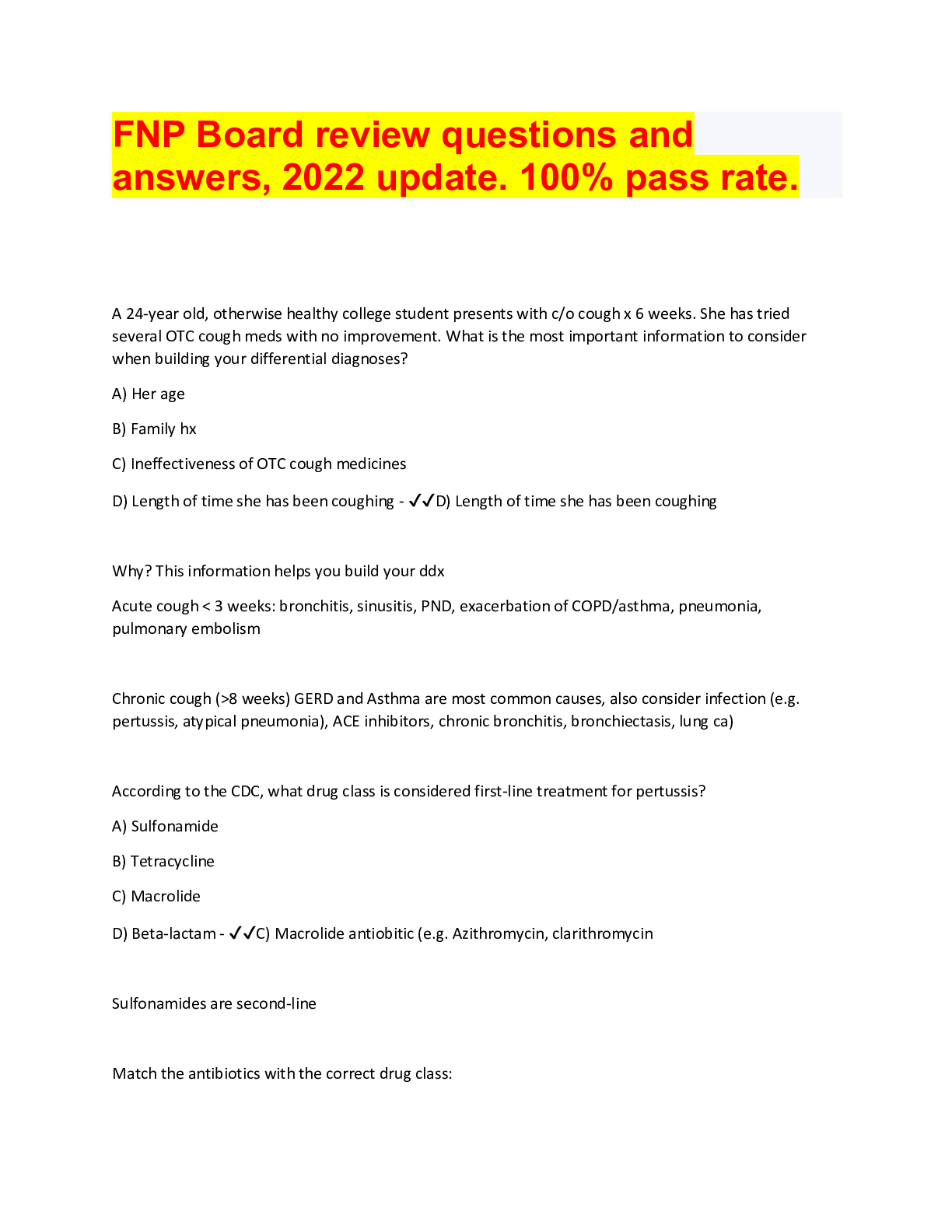
FNP BUNDLE,
All FNP exam quetions and answers, all you need.
By bundleHub Solution guider 1 year ago
$44
8
Reviews( 0 )
$13.00
Document information
Connected school, study & course
About the document
Uploaded On
Aug 20, 2022
Number of pages
262
Written in
Additional information
This document has been written for:
Uploaded
Aug 20, 2022
Downloads
0
Views
129






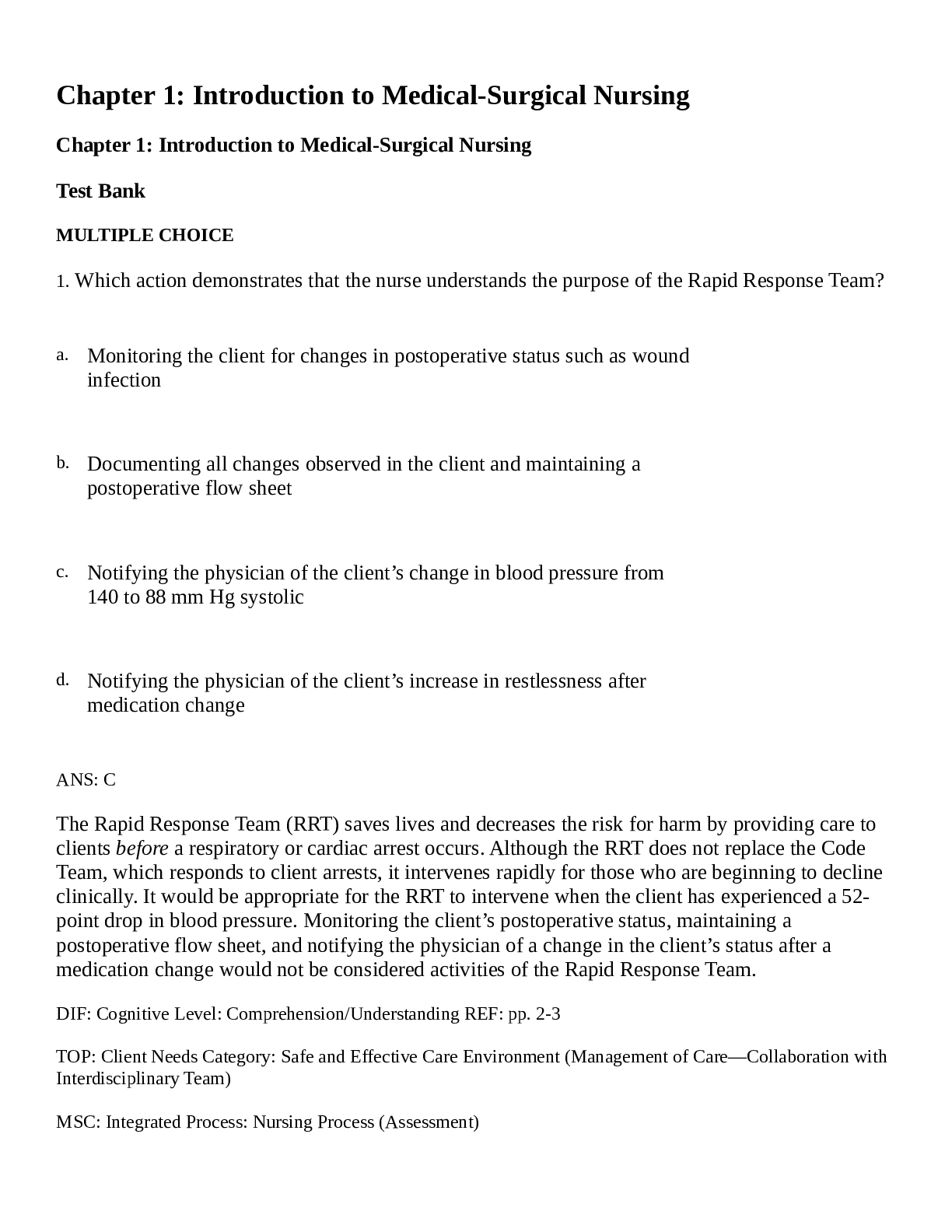


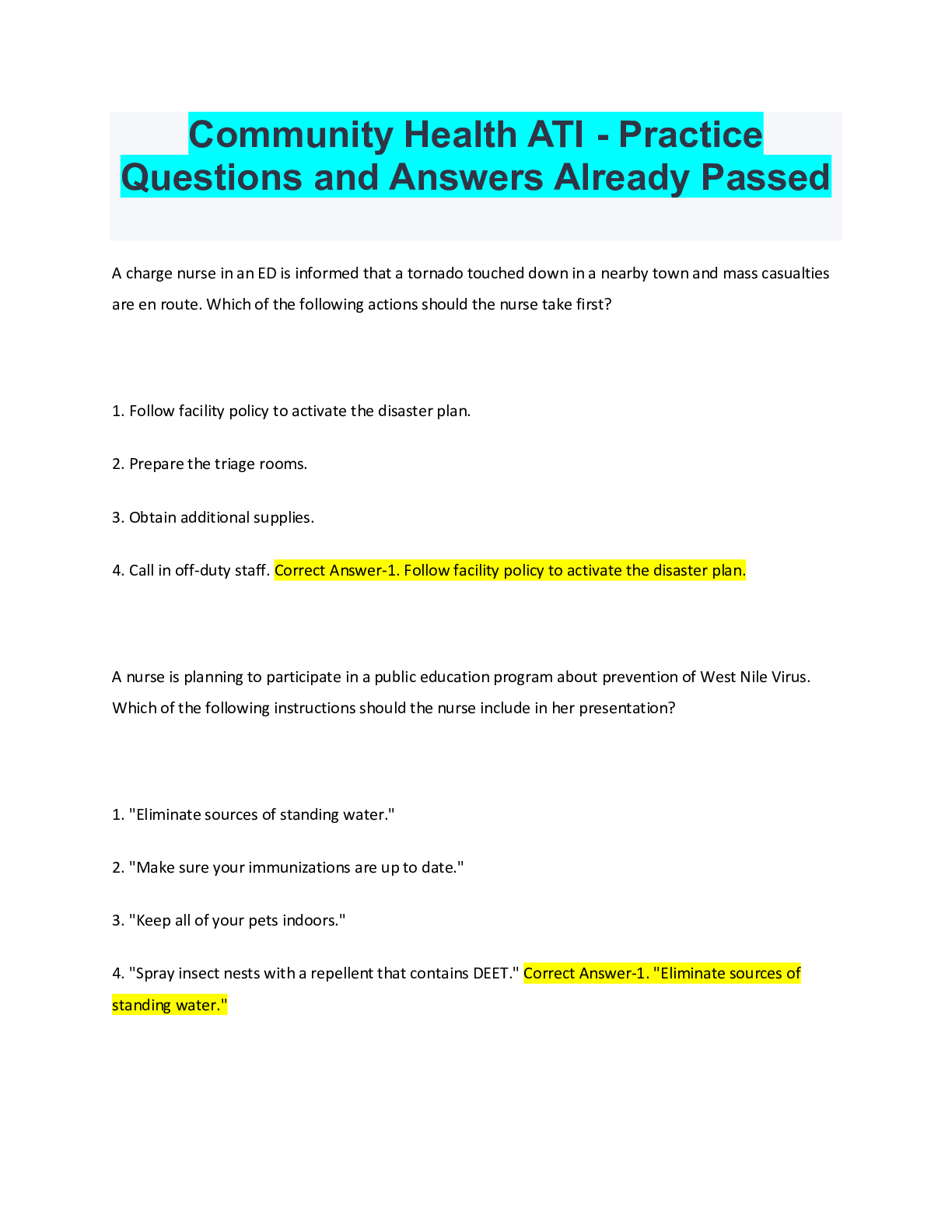
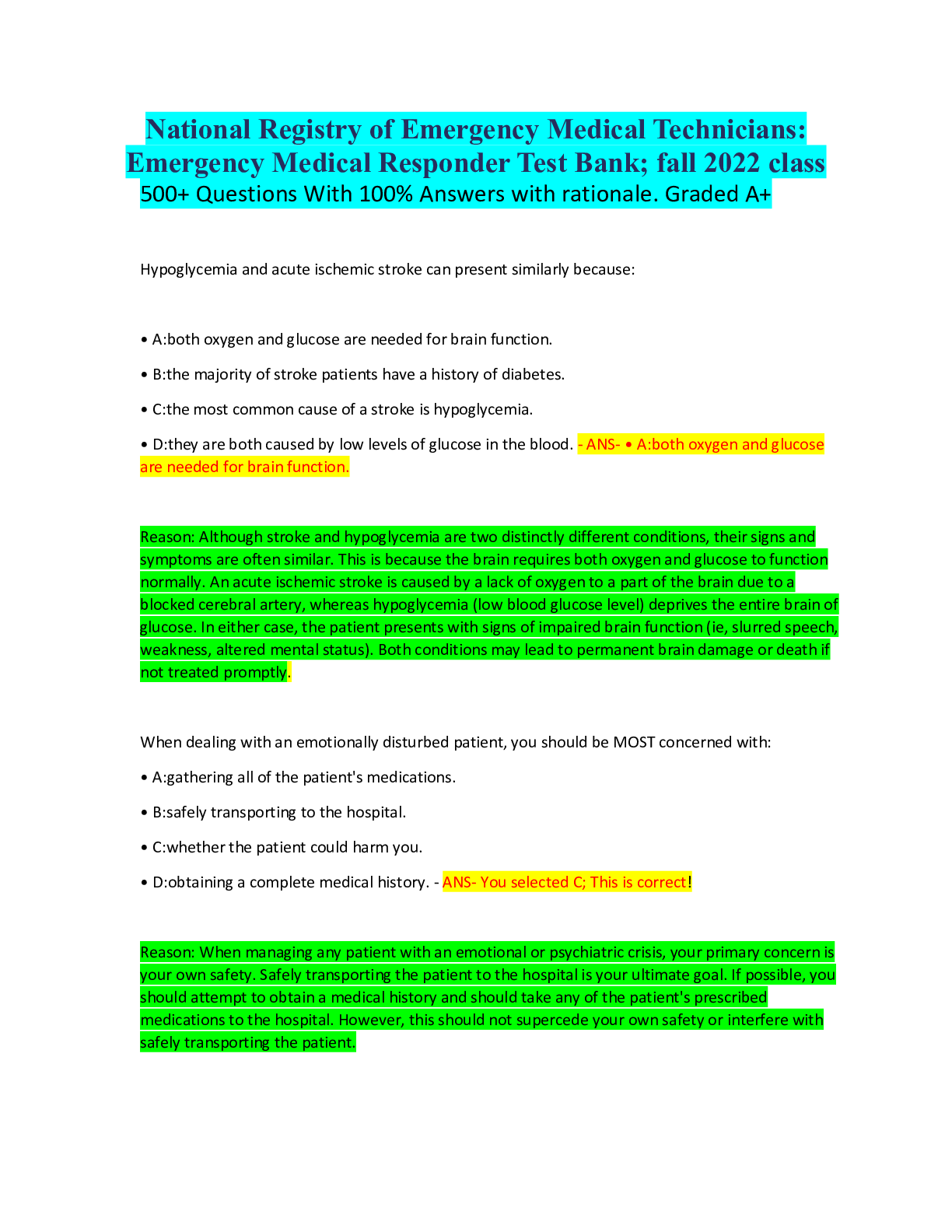

 ans.png)

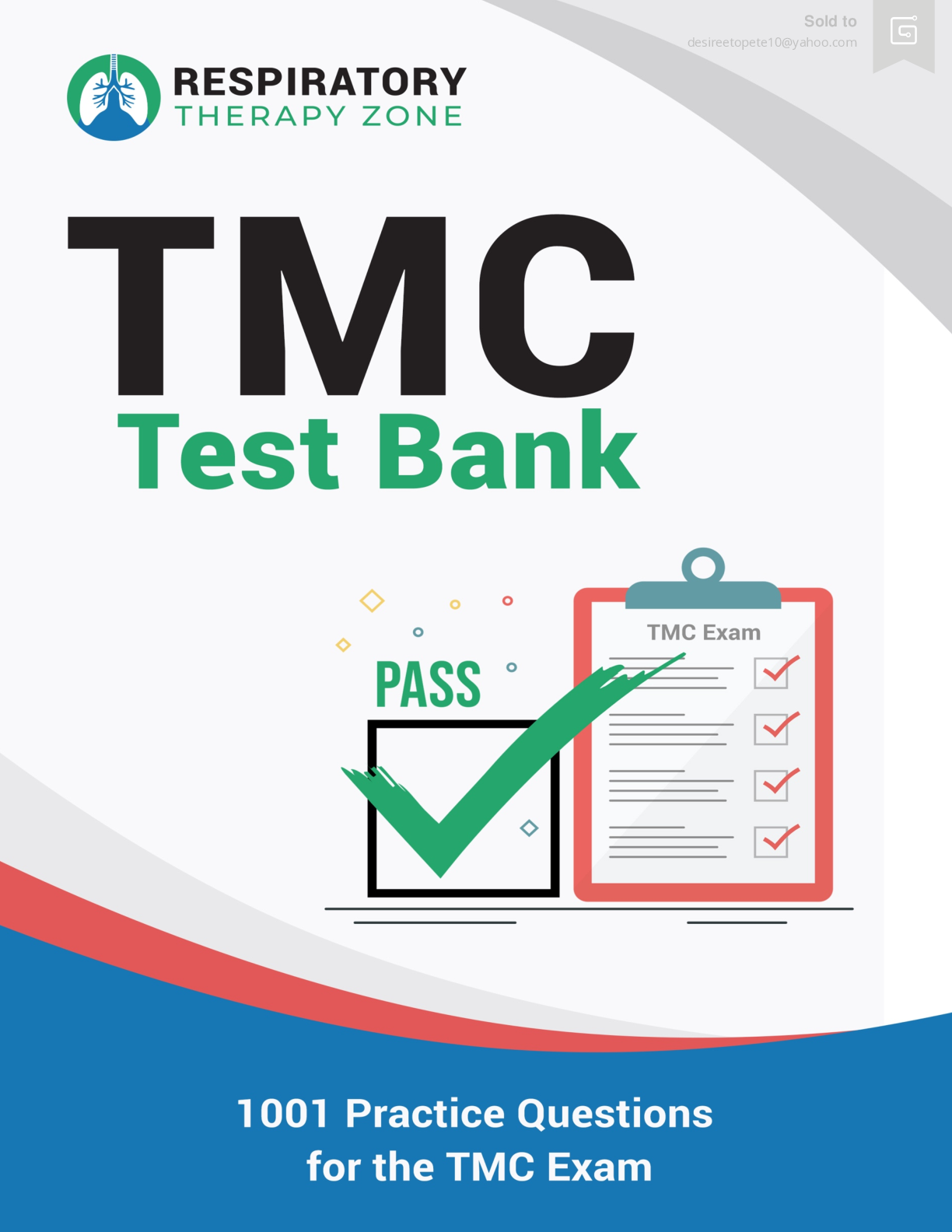
 UPDATED ON MARCH 19, 2022, BSN, R.png)
 Practice Quiz.png)
